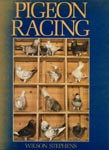 The
Raw Material of Life
The
Raw Material of Life
This introduces the importance of nutrition.
Food includes the substances of which racing pigeons (and ourselves and all other creatures) are made, and the fuel which energizes all activities. In the case of pigeons it gives power to their wings and stamina to their minds and nerves. Strong pigeons fly fast for as long as their impulsion to do so lasts. Impulsion lasts as long as their sense of wellbeing; and when that fades, only inherent determination can mobilize their remaining resources. So it is necessary that a bird sent to a race shall be at peak physical power, and in a state of confidence and contentment, so as to prolong its willingness and capability for fast flight and to postpone the moment when its last reserves are called upon.
The food intake of racing pigeons therefore divides into building materials (proteins and minerals), and fuels (carbohydrates). Pigeons being vegetarians, these requirements must be met by plant products - beans and grain providing them in their most concentrated form. The basic matter of obtaining them presents a flyer with no problem. All he has to do is pay. Reputable firms serving the sport offer balanced mixtures to meet all seasonal needs. However, such a basic matter as food does not simple very long in a sport as competitive as pigeon racing.
The individual, often secret traits of stockmanship which distinguish one man's methods from another's, naturally extend to the vital matter of the rations. Though most flyers feed the proprietary balanced mixtures most of them use their own favourite additives and variants to suit particular needs and circumstances. Additionally, as would be confirmed by spokesmen for the firms concerned, no set of customers could be more critical of the foodstuffs they buy than pigeon racers are.
The first need to be considered is the protein element, because unless a racing pigeon is soundly built no amount of energy-giving food wil enable it to fly fast. On the protein element depends the size and strength of the bird's main powerhouse, that greater pectoral muscle which, one-third of the bird's total weight, drives the down-beat of its wings. On the protein element also depends the quality of feather including the flights which,durable and tempered, are the pigeon's contact with the air. The producion of feather absorbs a quarter of each bird's protein intake throughout the year. Peas and beans are its main source.
The best peas (and the most expensive) are maples, preferably from New Zealand and sun-dried. A seasoned maple pea is so hard that its digestion by a bird seems something of a miracle, but in this case hard tack makes hard pigeons. The peas should be small enough to be swallowed without straining by the birds, round and full and not approaching black in colour. If New Zealand-grown there is seldom likelihood of this, but some English-grown maples are dark enough to be suspect, since their colour deepens in a wet harvest and such a crop may have deteriorated. Tic beans, though an excellent protein source, are sometimes too big for pigeons, but British growers have recently produced smaller varieties which overcome this problem.
The high-mileage months, when training and racing are going on, mean that pigeons need quick energy. The traditional forms of this are maize, small-grained varieties being essential, and oats. Wheat is valuable as the basis of maintenance rations during the months of reduced activity and growth between the end of the moult in autumn and the beginning of breeding in spring. But only as the basis; the bean and pea growth-foods must still be given but in smaller proportion.
The greatest energy-producer, and energy-replacer, of all grains is unpolished rice. It is of great value in the last few feeds before a race, and for the first few feeds afterwards, when a bird is recovering and re-building its reserves, Sometimes a pigeon loses 10 per cent of its weight in a race and special, easily digested foods are needed for quick replacement. Nearly every flyer has his own secret formula for this purpose. Canary seed and such oil-bearing, fat-forming grains as hemp, rape and linseed are much used, as are some pelleted poultry compounds. In America pigeon feeds are made up in pelleted form, and some are available in Britain.
Like all grain-eating birds, pigeons digest
their very hard mouthfuls by muscular contraction of the gizzard. So grit
must be supplied as a milling agent. It is advisable to buy this in package
form, since locally-dug grit may carry infection or contamination by farm
chemicals, however wholesome it seems.